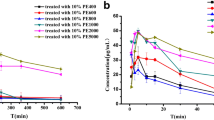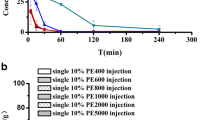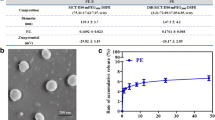Abstract
Accelerated blood clearance (ABC) is a phenomenon where the blood clearance rate of the carrier system is substantially raised. It can be induced by repetitive injections of polyethylene glycol (PEG) (molecular weight 2000)-modified micelles (PM2000). To determine whether the PEG chain length and PEGylated micelle injection dose can have an effect on the ABC phenomenon, micelles were modified with PEGs of varying molecular weights; PEGs with molecular weights of 350, 550, 2000, 5000, 10,000, and 20,000 were used to generate the PEGylated micelles PM350, PM550, PM2000, PM10000, and PM20000, respectively. One special carrier, MCT-PM2000, was prepared with the original PM2000 formulation but also included extra medium-chain triglycerides. Our experimental results showed that PM2000 and PM5000 exhibit superior storage stability compared to that of PM350, PM550, PM10000, and PM20000. MCT-PM2000 demonstrated stronger dilution stability than PM2000. As expected, PM2000 and PM5000 induced the strongest enhancement in blood elimination rate compared to that of PM350, PM550, PM10000, and PM20000; MCT-PM2000 exhibited more intense ABC phenomenon compared to that of PM2000. In addition, induction of the ABC phenomenon by PM2000 and MCT-PM2000 was augmented when the injection dose was increased from 0.05 to 5 μmol phospholipid·kg−1. Based on our findings, we suggest that there is a positive linear relationship between stability of PEG-modified micelles and susceptibility to the ABC phenomenon. The results may be valuable for designing PEGylated micelles for multiple drug therapy.







Similar content being viewed by others
Abbreviations
- 5%Glu:
-
5% (m/v) glucose for injection
- HLB:
-
the hydrophilic lipophilic balance
- CMC:
-
critical micellization concentration;
- AUC:
-
area under the curve
- MRT:
-
mean residence time
- DSPE-PEGx:
-
1,2-distearoyl-sn-glycero-3-phosphoethanolamine-n-[methoxy(polyethylene glycol)-x] (x = 350, 550, 2000, 5000, 10,000 and 20,000)
- MCT:
-
medium-chain triglycerides
- PM:
-
PEGylated micelles
- PE:
-
PEGylated emulsion
- PMy (y = 350, 550, 2000, 5000, 10,000 and 20,000):
-
micelles composed of DSPE-PEGx, x = 350, 550, 2000, 5000, 10,000 and 20,000, respectively
- MCT-PM2000:
-
micelles composed of DSPE-PEG2000 with MCT in the inner core (Weight of DSPE-PEG2000 weight of MCT, 14: 1, w/w)
- PMy-PE:
-
PMy were pre-administered into rats, and PE were injected 7 days later
- PM2000(zCMC)-PE:
-
PM2000 were pre-administered into rats at a dose of z-fold of the CMC of DSPE-PEG2000, and PE were injected 7 days later
- MCT-PM2000(zCMC)-PE:
-
MCT-PM2000 were pre-administered into rats at a dose of z-fold of the CMC of DSPE-PEG2000, and PE were injected 7 days later
- CMC2000:
-
the CMC value of the DSPE-PEG2000
- EE:
-
encapsulation efficiency
References
Dams ET, Laverman P, Oyen WJ, Storm G, Scherphof GL, van der Meer JW, et al. Accelerated blood clearance and altered biodistribution of repeated injections of sterically stabilized liposomes. J Pharmacol Exp Ther. 2000;292(3):1071–9.
Ishida T, Maeda R, Ichihara M, Mukai Y, Motoki Y, Manabe Y, et al. The accelerated clearance on repeated injection of pegylated liposomes in rats: laboratory and histopathological study. Cell Mol Biol Lett. 2002;7(2):286.
Zhao Y, Wang L, Yan M, Ma Y, Zang G, She Z, et al. Repeated injection of PEGylated solid lipid nanoparticles induces accelerated blood clearance in mice and beagles. Int J Nanomedicine. 2012;7:2891–900.
Saadati R, Dadashzadeh S, Abbasian Z, Soleimanjahi H. Accelerated blood clearance of PEGylated PLGA nanoparticles following repeated injections: effects of polymer dose, PEG coating, and encapsulated anticancer drug. Pharm Res. 2013;30(4):985–95.
Wang L, Wang C, Jiao J, Su Y, Cheng X, Huang Z, et al. Tolerance-like innate immunity and spleen injury: a novel discovery via the weekly administrations and consecutive injections of PEGylated emulsions. Int J Nanomedicine. 2014;9:3645–57.
Koide H, Asai T, Hatanaka K, Urakami T, Ishii T, Kenjo E, et al. Particle size-dependent triggering of accelerated blood clearance phenomenon. Int J Pharm. 2008;362(1–2):197–200.
Mima Y, Hashimoto Y, Shimizu T, Kiwada H, Ishida T. Anti-PEG IgM is a major contributor to the accelerated blood clearance of polyethylene glycol-conjugated protein. Mol Pharm. 2015;12(7):2429–35.
Im H-J, England CG, Feng L, Graves SA, Hernandez R, Nickles RJ, et al. Accelerated blood clearance phenomenon reduces the passive targeting of PEGylated nanoparticles in peripheral arterial disease. ACS Appl Mater Interfaces. 2016;8(28):17955–63.
Du N, Guo W, Yu Q, Guan S, Guo L, Shen T, et al. Poly (D, L-lactic acid)-block-poly (N-(2-hydroxypropyl) methacrylamide) nanoparticles for overcoming accelerated blood clearance and achieving efficient anti-tumor therapy. Polym Chem. 2016;7(36):5719–29.
Gaucher G, Dufresne M-H, Sant VP, Kang N, Maysinger D, Leroux J-C. Block copolymer micelles: preparation, characterization and application in drug delivery. J Control Release. 2005;109(1–3):169–88.
Matsumura Y, Hamaguchi T, Ura T, Muro K, Yamada Y, Shimada Y, et al. Phase I clinical trial and pharmacokinetic evaluation of NK911, a micelle-encapsulated doxorubicin. Brit J Cancer. 2004;91(10):1775–81.
Matsumura Y. Poly (amino acid) micelle nanocarriers in preclinical and clinical studies. Adv Drug Deliv Rev. 2008;60(8):899–914.
Hamaguchi T, Kato K, Yasui H, Morizane C, Ikeda M, Ueno H, et al. A phase I and pharmacokinetic study of NK105, a paclitaxel-incorporating micellar nanoparticle formulation. Brit J Cancer. 2007;97(2):170–6.
Shiraishi K, Hamano M, Ma H, Kawano K, Maitani Y, Aoshi T, et al. Hydrophobic blocks of PEG-conjugates play a significant role in the accelerated blood clearance (ABC) phenomenon. J Control Release. 2013;165(3):183–90.
Ma H, Shiraishi K, Minowa T, Kawano K, Yokoyama M, Hattori Y, et al. Accelerated blood clearance was not induced for a gadolinium-containing PEG-poly (L-lysine)-based polymeric micelle in mice. Pharm Res. 2010;27(2):296–302.
Kaminskas LM, Mcleod VM, Porter CJ, Boyd BJ. Differences in colloidal structure of PEGylated nanomaterials dictate the likelihood of accelerated blood clearance. J Pharm Sci. 2011;100(11):5069–77.
Ishida T, Ichikawa T, Ichihara M, Sadzuka Y, Kiwada H. Effect of the physicochemical properties of initially injected liposomes on the clearance of subsequently injected PEGylated liposomes in mice. J Control Release. 2004;95(3):403–12.
Ishida T, Harada M, Wang XY, Ichihara M, Irimura K, Kiwada H. Accelerated blood clearance of PEGylated liposomes following preceding liposome injection: effects of lipid dose and PEG surface-density and chain length of the first-dose liposomes. J Control Release. 2005;105(3):305–17.
Zhao Y, Wang C, Wang L, Yang Q, Tang W, She Z, et al. A frustrating problem: accelerated blood clearance of PEGylated solid lipid nanoparticles following subcutaneous injection in rats. Eur J Pharm Biopharm. 2012;81(3):506–13.
Perrier T, Saulnier P, Fouchet F, Lautram N, Benoît J-P. Post-insertion into lipid nanocapsules (LNCs): from experimental aspects to mechanisms. Int J Pharm. 2010;396(1–2):204–9.
Sezgin Z, Yüksel N, Baykara T. Preparation and characterization of polymeric micelles for solubilization of poorly soluble anticancer drugs. Eur J Pharm Biopharm. 2006;64(3):261–8.
Wang C, Cheng X, Su Y, Pei Y, Song Y, Jiao J, et al. Accelerated blood clearance phenomenon upon cross-administration of PEGylated nanocarriers in beagle dogs. Int J Nanomedicine. 2015;10:3533–45.
Su Y, Wang L, Liang K, Liu M, Liu X, Song Y, et al. The accelerated blood clearance phenomenon of PEGylated nanoemulsion upon cross administration with nanoemulsions modified with polyglycerin. Asian J Pharm Sci. 2018;13:44–53.
Kim SY, Shin IG, Lee YM, Cho CS, Sung YK. Methoxy poly (ethylene glycol) and ϵ-caprolactone amphiphilic block copolymeric micelle containing indomethacin.: II Micelle formation and drug release behaviours. J Control Release. 1998;51(1):13–22.
Liang K, Wang L, Su Y, Liu M, Feng R, Song Y, et al. Comparison among different “revealers” in the study of accelerated blood clearance phenomenon. Eur J Pharm Sci. 2018;114:210–6.
Sen S, Sukul D, Dutta P, Bhattacharyya K. Solvation dynamics in aqueous polymer solution and in polymer−surfactant aggregate. J Phys Chem B. 2002;106(15):3763–9.
Ishida T, Ichihara M, Wang X, Yamamoto K, Kimura J, Majima E, et al. Injection of PEGylated liposomes in rats elicits PEG-specific IgM, which is responsible for rapid elimination of a second dose of PEGylated liposomes. J Control Release. 2006;112(1):15–25.
Ishida T, Wang X, Shimizu T, Nawata K, Kiwada H. PEGylated liposomes elicit an anti-PEG IgM response in a T cell-independent manner. J Control Release. 2007;122(3):349–55.
Ishida T, Ichihara M, Wang X, Kiwada H. Spleen plays an important role in the induction of accelerated blood clearance of PEGylated liposomes. J Control Release. 2006;115(3):243–50.
Nicolai T, Colombani O, Chassenieux C. Dynamic polymeric micelles versus frozen nanoparticles formed by block copolymers. Soft Matter. 2010;6(14):3111–8.
Bae YH, Yin H. Stability issues of polymeric micelles. J Control Release. 2008;131(1):2–4.
Semple SC, Harasym TO, Clow KA, Ansell SM, Klimuk SK, Hope MJ. Immunogenicity and rapid blood clearance of liposomes containing polyethylene glycol-lipid conjugates and nucleic acid. J Pharmacol Exp Ther. 2005;312(3):1020–6.
Shimizu T, Ishida T, Kiwada H. Transport of PEGylated liposomes from the splenic marginal zone to the follicle in the induction phase of the accelerated blood clearance phenomenon. Immunobiology. 2013;218(5):725–32.
Ishida T, Atobe K, Wang X, Kiwada H. Accelerated blood clearance of PEGylated liposomes upon repeated injections: effect of doxorubicin-encapsulation and high-dose first injection. J Control Release. 2006;115(3):251–8.
Kim CJ, Hara E, Shimizu A, Sugai M, Kimura S. Activation of B1a cells in peritoneal cavity by T cell-independent antigen expressed on polymeric micelle. J Pharm Sci. 2015;104(5):1839–47.
Kaminskas LM, Mcleod VM, Porter H, Christopher J, Boyd BJ. Differences in colloidal structure of PEGylated nanomaterials dictate the likelihood of accelerated blood clearance. J Pharm Sci. 2011;100(11):5069–77.
Hashimoto Y, Shimizu T, Lila ASA, Ishida T, Kiwada H. Relationship between the concentration of anti-polyethylene glycol (PEG) immunoglobulin M (IgM) and the intensity of the accelerated blood clearance (ABC) phenomenon against PEGylated liposomes in mice. Biol Pharm Bull. 2015;38(3):417–24.
Ishida T, Kashima S, Kiwada H. The contribution of phagocytic activity of liver macrophages to the accelerated blood clearance (ABC) phenomenon of PEGylated liposomes in rats. J Control Release. 2008;126(2):162–5.
Hara E, Ueda M, Makino A, Hara I, Ozeki E, Kimura S. Factors influencing in vivo disposition of polymeric micelles on multiple administrations. ACS Med Chem Lett. 2014;5(8):873–7.
Funding
This research was supported by the National Natural Science Foundation of China (Grant Nos. 81072602, 81373334).
Author information
Authors and Affiliations
Corresponding authors
Ethics declarations
All institutional and national guidelines for the care and use of laboratory animals were followed.
Conflict of interest
The authors declare that they have no conflicts of interest.
Electronic supplementary material
ESM 1
(DOC 43 kb)
Rights and permissions
About this article
Cite this article
Su, Y., Liu, M., Xiong, Y. et al. Effects of stability of PEGylated micelles on the accelerated blood clearance phenomenon. Drug Deliv. and Transl. Res. 9, 66–75 (2019). https://doi.org/10.1007/s13346-018-0588-3
Published:
Issue Date:
DOI: https://doi.org/10.1007/s13346-018-0588-3




